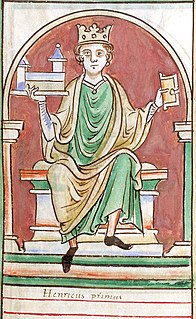
Henry I, also known as Henry Beauclerc, was King of England from 1100 to his death in 1135. Henry was the fourth son of William the Conqueror and was educated in Latin and the liberal arts. On William's death in 1087, Henry's elder brothers Robert Curthose and William Rufus inherited Normandy and England, respectively, but Henry was left landless. Henry purchased the County of Cotentin in western Normandy from Robert, but William and Robert deposed him in 1091. Henry gradually rebuilt his power base in the Cotentin and allied himself with William against Robert. Henry was present when William died in a hunting accident in 1100, and he seized the English throne, promising at his coronation to correct many of William's less popular policies. Henry married Matilda of Scotland but continued to have a large number of mistresses by whom he had many illegitimate children.

William Blake was an English poet, painter, and printmaker. Largely unrecognised during his lifetime, Blake is now considered a seminal figure in the history of the poetry and visual arts of the Romantic Age. What he called his prophetic works were said by 20th-century critic Northrop Frye to form "what is in proportion to its merits the least read body of poetry in the English language". His visual artistry led 21st-century critic Jonathan Jones to proclaim him "far and away the greatest artist Britain has ever produced". In 2002, Blake was placed at number 38 in the BBC's poll of the 100 Greatest Britons. While he lived in London his entire life, except for three years spent in Felpham, he produced a diverse and symbolically rich œuvre, which embraced the imagination as "the body of God" or "human existence itself".
William I, usually known as William the Conqueror and sometimes William the Bastard, was the first Norman King of England, reigning from 1066 until his death in 1087. A descendant of Rollo, he was Duke of Normandy from 1035 onward. After a long struggle to establish his power, by 1060 his hold on Normandy was secure, and he launched the Norman conquest of England six years later. The rest of his life was marked by struggles to consolidate his hold over England and his continental lands and by difficulties with his eldest son.

William IV was King of the United Kingdom of Great Britain and Ireland and King of Hanover from 26 June 1830 until his death in 1837. The third son of George III, William succeeded his elder brother George IV, becoming the last king and penultimate monarch of Britain's House of Hanover.

William III, also widely known as William of Orange, was sovereign Prince of Orange from birth, Stadtholder of Holland, Zeeland, Utrecht, Gelderland and Overijssel in the Dutch Republic from 1672 and King of England, Ireland and Scotland from 1689 until his death in 1702. As King of Scotland, he is known as William II. He is sometimes informally known in Northern Ireland and Scotland as "King Billy".

Prince William, Duke of Cambridge, is a member of the British royal family. He is the elder son of Charles, Prince of Wales, and Diana, Princess of Wales. Since birth, he has been second in the line to succeed his grandmother Elizabeth II, who is queen of the United Kingdom and 15 other Commonwealth realms.

Catherine, Duchess of Cambridge,, is a member of the British royal family. Her husband, Prince William, Duke of Cambridge, is expected to become king of the United Kingdom and 15 other Commonwealth realms, making Catherine a likely future queen consort.
Brian Trevor John Murphy is an English actor and comedian, best known as the henpecked husband George Roper in the popular sitcom Man About the House and its spin-off series George and Mildred, and as Alvin Smedley in Last of the Summer Wine.
Kate Anthony is an English actress best known for her role as Pam Hobsworth on the ITV soap Coronation Street.

When We Are Married is a comedy by the English dramatist, J. B. Priestley. It was first performed in London at the St. Martin's Theatre, London on 11 October 1938, and transferred to the larger Prince's Theatre in March 1939 and ran until 24 June of that year.

The Khelma or Khelma/Sakachep are one of the old Kuki tribes of Northeastern parts of India.

Sunderland Greyhound Stadium is a greyhound racing track situated at Fulwell in the City of Sunderland and English county of Tyne and Wear. The stadium is owned by ARC and racing takes place every Wednesday and Friday evening as well as an additional BAGS meeting on Tuesdays, Thursdays and Sundays. The circumference of the track is 378 metres.
Ethel Coleridge was an English actress, best known for her roles in the original Aldwych farces in the 1920s and 1930s.

When We Are Married is a 1943 British comedy-drama film directed by Lance Comfort and starring Sydney Howard, Raymond Huntley and Olga Lindo.
Charles Crossland was an English mycologist.
Spennymoor Greyhound Stadium was a greyhound racing stadium in Spennymoor, County Durham.
The 2002 Irish Greyhound Derby took place during August and September with the final being held at Shelbourne Park in Dublin on 14 September 2002.
The 2004 Irish Greyhound Derby took place during August and September with the final being held at Shelbourne Park in Dublin on 18 September 2004.
The 1991 UK & Ireland Greyhound Racing Year was the 65th year of greyhound racing in the United Kingdom and Ireland.
The 2002 UK & Ireland Greyhound Racing Year was the 76th year of greyhound racing in the United Kingdom and Ireland.











